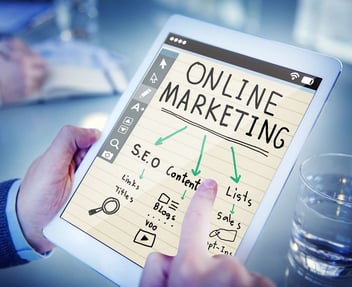Successful LinkedIn Advertising in 4 Quick Steps
LinkedIn is growing as a social media platform, and with it comes expanding space and opportunities for advertising. LinkedIn ads are a great opportunity you should be taking advantage of. Here are four things that should shape your LinkedIn ad strategy.

1. Have Your Goals Set Out
There's no point in running ads if you don't have a specific plan for what you want your ads to achieve. Ads can be used to fulfill several goals. It doesn't matter which one you are using ads for as long as you keep your eyes on your ultimate objective and plan for it. If you have a clear goal, you will have an easier time getting the other article's other steps down. Here's a list of goals that help you optimize your LinkedIn Ad Performance:
-
Clicks: You want people to click on the ad and visit your website, pure and simple. Driving traffic is probably the most common goal for LinkedIn ads.
-
Engagement: This is when you want to increase engagement with your content and your profiles.
-
Product promotion: When you have a new product or service you wish to promote to make your target audience aware of its launch.
-
Employee prospecting: If you're looking to hire new employees, ads are an excellent way to reach them. LinkedIn is the perfect place to advertise to potential employees.
The list of goals isn't limited to this, but hopefully, this gave you an idea of framing your ad campaign goals. Remember that all this is on Linkedin; it will not always be the same as a more traditional ad campaign.
2. Aim For The Right Audience
The most important thing when it comes to advertising is precision. You want to understand your audience before considering what ads you will push out. You need to know exactly who you're targeting and what they like and want to see, and then you can figure out what you will show them.
LinkedIn ads let you target people through a variety of filters, such as:
-
Job title
-
Experience
-
Company name or general field of work
-
Education
-
Skills
-
Social factors (age, gender, etc.)
Thanks to these filtering options, ads on Linkedin can be tailored to precisely the right personages you want to see them. All you need to do is figure out how to use these tools to target the right people and let the algorithms do the rest of the work for you.
3. Pick The Right Kind of Ad
Once you know who you're targeting, picking the correct type of ad is the next big step. Linkedin ads offer a fair amount of variety when choosing the right ad. Sponsored Content, InMail, and Text Ads are the three most significant options.
-
Sponsored content ads appear on feeds when LinkedIn members use the website (or the app). These ads are mixed in with other updates on a user's feed. The cost of running sponsored content is calculated upfront based on the exposure you want on people's feeds. You can use simple text or complement your text with multimedia content like images or short videos.
-
Text Ads show up on the sidebar of the LinkedIn website. They're not as integrated into the LinkedIn experience as sponsored content ads are, and they operate more similarly to pay-per-click ads - the more people click, the more you pay for the ad. The upside of text ads is that you can get a more precise idea of how your ad is effective (by looking at clicks), but given that it's more intrusive than sponsored content ads, it's not always the most straightforward choice. Text ads are usually cheaper but less effective than other ads. The most significant disadvantage of text ads is that you're limited to using text and don't have the same freedom as in other ad types.
-
Sponsored InMail ads are ads that are sent directly to users' inboxes. They're not integrated seamlessly into LinkedIn's user experience, but they are more directly addressed to them. Sponsored InMail ads feel less like giant billboards being shown to everyone and more like personalized messages being sent privately (because that's what it is). You have the freedom to add multimedia to these ads, but for the most part, they're text-based since they operate through LinkedIn's messaging function. The downside is that this type can be very hit or miss. Many people dislike having advertising directly in their inboxes, and you could give the wrong message to people you're trying to attract. Be careful with your tone and approach. If you're too dry, then people could easily be put off by you. If you're too comfortable, people may not even realize it's an ad and may attempt to respond - and you don't want to be managing that many conversations.
The type of ad you want to use will change depending on your target audience. If personalization is the most important thing, consider sponsored InMail or sponsored content ads. If you can get away with less and want to reach a broad audience, look at text ads. If your budget allows it, you can pick multiple ad types for the most exposure. Be careful, though - you don't want to overexpose your target audience to ads; it could put them off.
4. Pick The Right ad Format
Each ad type allows for different ad formats, depending on your chosen type. Your ad's structure will largely depend on what kind of content you choose to include in your ad. Remember that some ad types cannot involve some formats (for example, text ads cannot incorporate videos), so not all formats can be applied to all ad types. Here are the main formats you can choose from:
-
Single-image ads are the most popular ads on Linkedin. It's a simple ad with one carefully selected image accompanying some text.
-
Carousel ads are exclusive to sponsored content. You can use more than a single image in these kinds of ads. They come in handy if you're trying to show off more than a single product you're launching or can't get the message across with just one image.
-
Video ads are more interactive than image ads. They can deliver more information than text in the same space, and you can show more than you could with one image. You can also incorporate music or other sound effects to complement your ad better.
-
Follower ads drive people to your LinkedIn page and get more followers. They're not about selling products and services. It's just about getting followers for your page. It's the most useful for growing your following on Linkedin.
-
Spotlight ads are specifically designed to advertise products and services. If you have a specific product you just launched and want to focus your ads on that product, spotlight ads are the best option.
-
Job ads invite potential employees to check out your company and see if they want to work with you. It's not the most common ad on most websites, but there's no better place than LinkedIn to run job ads.
Overall, including LinkedIn as a part of a general marketing plan or as your only avenue for advertising and recruiting is a prudent investment.
This content is also available in:
- German: Erfolgreiche LinkedIn Werbung in 4 schnellen Schritten
- Spanish: Publicidad exitosa en LinkedIn en 4 pasos rápidos
- French: Une publicité LinkedIn réussie en 4 étapes rapides
- Italian: Pubblicità di successo su LinkedIn in 4 rapidi passi
- Romanian: Publicitate de succes pe LinkedIn în 4 pași rapizi
- Chinese: 用 4 个快速步骤成功发布 LinkedIn 广告








Leave a Comment